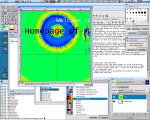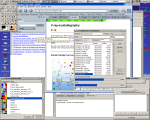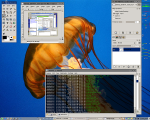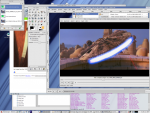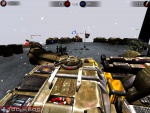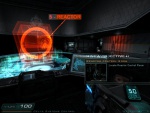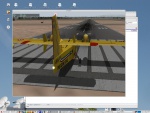Linux
Contents
My Linux-experience
OK, to fill some pages I will write down something about my experience with Linux, what I am doing with it and things which are still missing from an end-users point of view.
First of all, I have created the most recent version of this page with Linux tools alone. Some images and older sediments of my site may incorporate Windows-generated images, but nowadays I have switched to Open source tools to create everything I want to show here.
Currently I'm developing Web-based applications on Linux- and Apple-machines, using Mozilla, PHP, Perl, Python, Webware, PostgreSQL, MySQL, Eclipse and Emacs (well, Emacs not so much any more...) to program distributed bioinformatics database-applications.
Beside that I was heavily depending on a stable machine to do my Ph.D., which was one of the two main reasons for switching from Windows NT to SuSE-Linux and finaly Fedora Core.
Pictures
Because people always want to see screenshots here are some of my home-desktop. They are slightly recursive, the first one shows an editing-session of this HTML-page, running SuSE 7.3/KDE 2.2 with an IceWM-theme, the second one shows the upload of the homepage, running SuSE 8.1/KDE 3.0 with the Quartz theme and some nice tools. The third one is SuSE 9.1 KDE 3.2.1 and Gimp 2.0 and the right-most is the recent Fedora Core 3 installation on my new AMD Athlon64 running Gnome 2.8. Apparently I like blue backgrounds...
Installing Linux on Laptops.
During my work for Exelixis, I had an IBM R32 laptop running SuSE 8.1 and during my stay back at the university, I had a Toshiba M30-344[pdf-file], which I used with SuSE 9.0 and 9.1.
Short note: Both pages will not get updates, as I don't own those laptops any more.
Blue pill or red pill...
Gentoo Linux on Small Systems
Installing one of the more recent distros on an old system (aka my 300 MHz PII) is not really fun.
Except for the fact, that a small hard disk is quickly filled up by a load of gunk you might not need at all (but which is installed anyway, if you don't select rpm-packages by hand), those distros tend to be painfully slow (the current version of Quanta IS dead-slow even on my AMD Duron 700 (yess, CPUs have arrived ad 6.0 GHz meanwhile, I know)), and take eons to load the desktop (why? I was running Linux on my 486 ages ago).
There seems to be no real hope for a fast-and-small version of SuSE, therefore I had to look for something else.
Enter Gentoo-Linux: (I have to admit, that almost everything which follows, has been stolen from an email I got from a friend, who setup all this on his machine ;-)).
Anyway, if you are interested in my installation-notes for a small-footprint Gentoo-system, read on.
Fedora Core 3 Workstation Installation Notes
Roughly 2 years ago I switched from my long-time favorite Linux-distribution to Fedora Core 3. Read my Fedora Core 3 Linux-notes for this, if you want.
Fedora Core 6 Workstation Installation Notes
Most recently I decided to update my system to a newer version of Fedora, version 6. Read my Fedora Core 6 Linux installation notes if you want.
CentOS
Some time ago I had to setup a 64-bit 4-way server and decided to give CentOS a shot. Having ordered a floppy-drive ("who really needs that nowadays") immediately paid off, because the RAID-Controller was not recognized and a newer kernel-module had to be installed from a boot-floppy (not a problem, unless you can't use one).
Read my CentOS installation notes if you want.
Ubuntu Linux
It's .... "brown"? Besides, it has some strange glitches regarding the console and special signs. Font size problems crop up in Firefox after installation. So what should I say: I'm not too impressed and really don't get the hype surrounding this distro (as compared to SuSE or Fedora). Installation went pretty painless, but so did the installation of FC3 and most SuSE versions. Feature-wise, you need to add a lot of stuff to get a usable system afterwards, which is not exactly easier or more difficult than in any other well-maintained distro. Disabling the ugly default brown theme (including login and stupid branding logos) was kind of a pain in the ass. If only they could provide an alternative look-and-feel...
Gaming
There are some decent games out there, which run natively on Linux (see above :-) ).
Unfortunately of course, most software now is developed with DirectX instead of OpenGL, making a port to Linux even harder (surprise...).
Running Windows games on Linux is mostly not fun. Read my Wine and Cedega rant for more on that.
